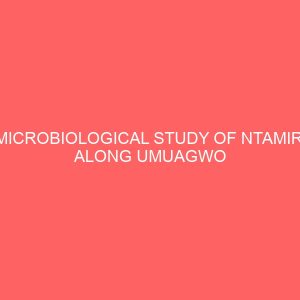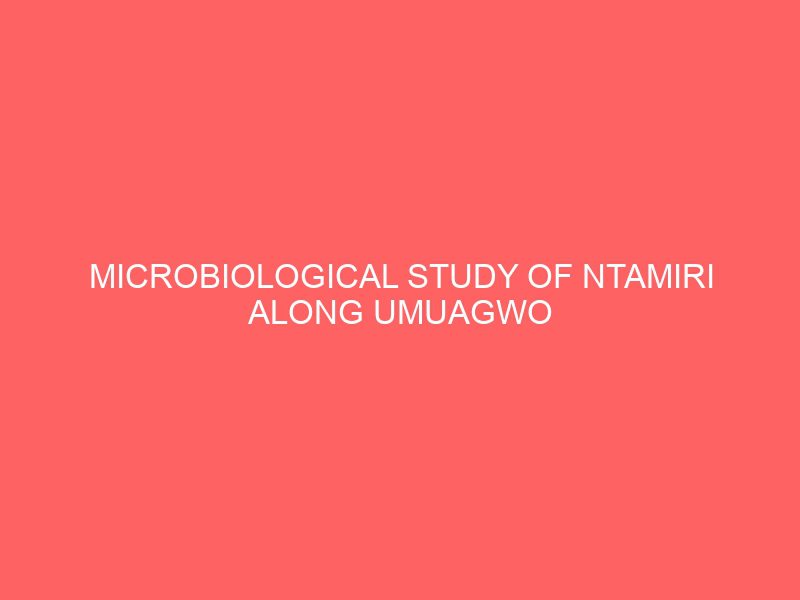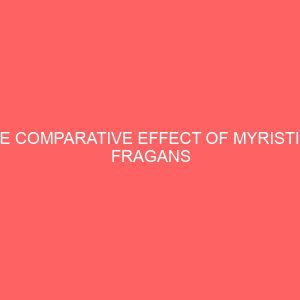Description
CHAPTER ONE
1.0 INTRODUCTION
This research is on Microbiological study of Ntamiri along Umuagwo axis of the stream. Water is a liquid mineral. It consists of two atoms of hydrogen combined with one atom of oxygen. Water is a tasteless, odourless and colourless mobile liquid except in large volume where it appears blue. It has a melting point of OoC (320f) and a boiling point of 1000C (2120f). Water is a basic necessity of life; in the absence higher animals survive only but a few hours or days. It has several uses such as washing cooking, food processing, swimming, and among others. Out of these uses, drinking of water seems to be the most sensitive as it could have a direct deleterious impact on health of human beings.
Therefore, drinking water should be potable free diseases, or toxic substance (Beren 1991). Water is portable when it is colorless. odorless, or tasteless and also free from poisonous, corroding, staining substances as well as disease causing organisms (Cruich 1972). The problem of providing safe and adequate water is as old as life on earth. Water can be made unifit or unsafe for drinking it contamination occurs either by nature or activities of human beings.
Perhaps the greatest danger associated with drinking water is contamination by human excrement (Forest 1979). In most cases, the pollution/contamination is hardly severe and is not particularly detrimental to health.
Thus a few substances and microbes that are health hazard do occur in water, and can cause illness or even death. From microbiological point of view, the pathogens most frequently transmitted through water supply ranges from ultrasmall virus to the microscopic bacteria and relatively large cysts entemoeba instolytica. These organisms cense infections of intestinal track, when consumed censing amebic dysentery, and Gardia lamblia is a protozoa responsible for Giadiasis. Defective plumbing for example was the cause of out break during the world fair in Chicago 1933 (Garelick 1987) water borne disease cause acute diarrhea, often last 2-3 months. The most common water borne disease can be by bacteria includes typhoid fever, paratyphoid. Asiatic cholera and bacteria dysentery.
Other diseases that may be transmitted by water include brucellosis, shige /losis, these diseases are consuming. Untreated water (Hetolett 1921) various countries of the world and the world Health organization (WHO) has set up standards for water quality against which the level of pollution can be assessed. The world Health organization (WHO) National Agency for food and Drug Administration control (NAFDAC), standard for potable water include the following, that in 100ml of water coliform bacteria should be absent, total plate count of bacteria growth should be 100 CFU/ML of water. Hence the sanitary Quality of water should not be over looked since contaminated water can cause health hazards when consumed.
1.1 AIMS / OBJECTIVES OF THE STUDY
The objective of this project is to make Microbiological study of Ntamiri Rivers along Umuagwo axis.
To identify contamination microbial advice on measures to control pollution of water bodies etc.
1.2 STATEMENT OF PROBLEMS
The treated water produced by Ntamiri Rivers could be contaminated by defective plumbing which cause the rush of water out of the pipe forming pull mixed with sewage matters. The pull eventually sucks back through the burst pipe into the pipe line being distributed to various locations and collected as drinking water.
1.3 HYPOTHESIS
H.O: there is difference in the microbial load of water from Ntamiri River at point of production against the load as the point of supply and consumption.
HI: There is a statistical difference between the microbial load of water from the Ntamiri Rivers as the production point against the load as supply and consumption point.
1.4 SCOPE OF LIMITATION
The project is set to identify only microbial pollutants the method of microbial analysis is limited to the techniques and materials available in our laboratory as against high tech equipment which may be found else where.







